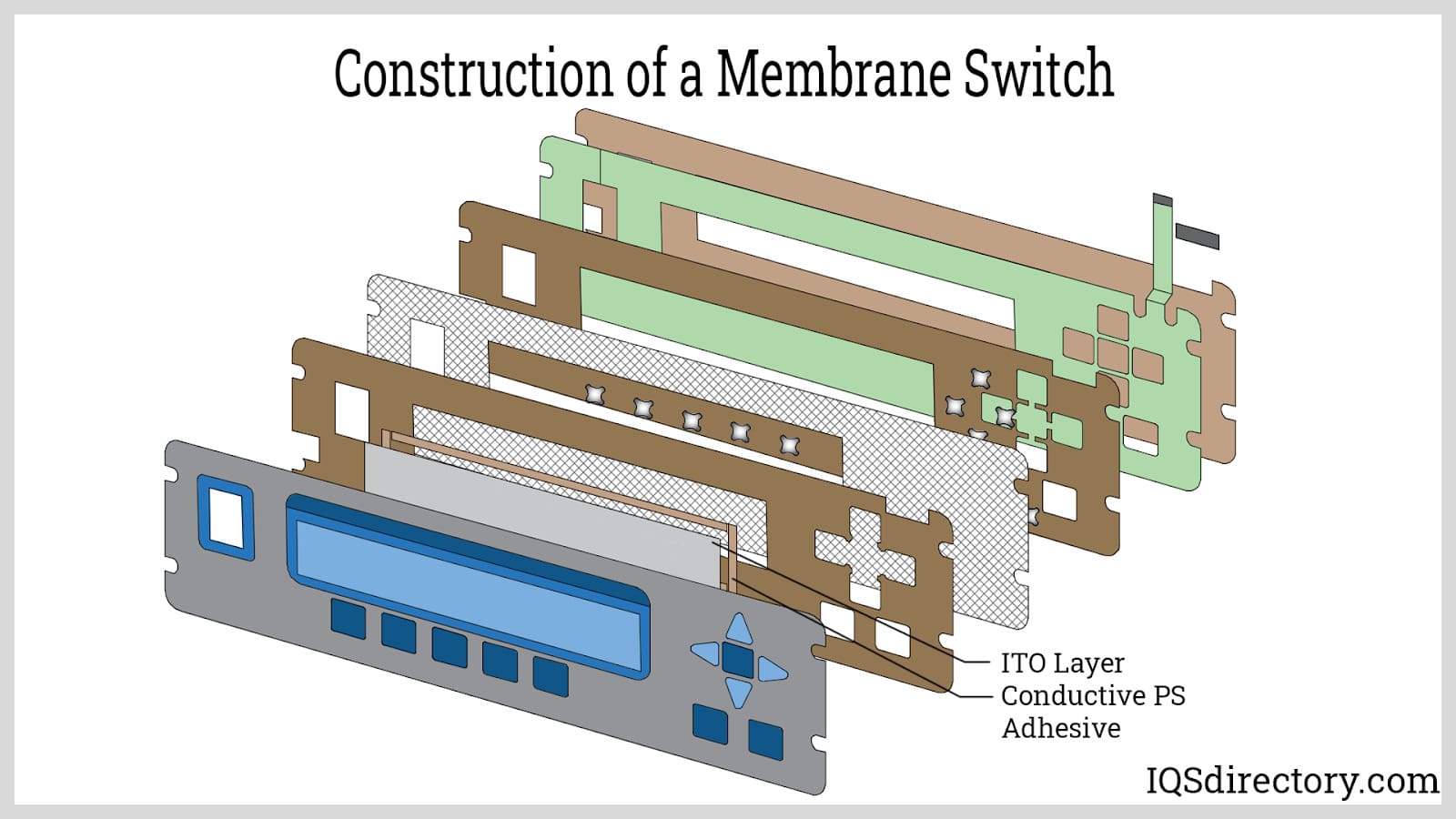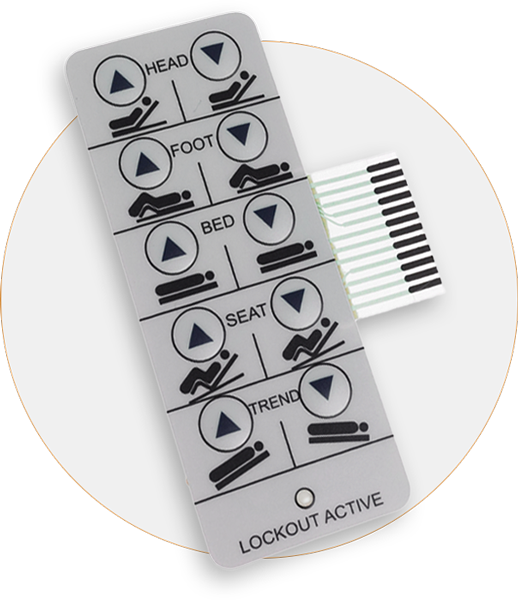Understanding the Durability and Versatility of a Membrane Switch
Wiki Article
Understanding Membrane Switches Over: The Trick to Sturdy and Dependable Controls
Membrane changes stand for an essential facet of contemporary interface layout, mixing performance with durability in various applications. These versatile parts not just assist in user interaction yet are additionally engineered to endure the roughness of demanding settings, from medical gadgets to commercial equipment. Understanding their building and construction, procedure, and the myriad advantages they supply is crucial for designers and engineers alike. As we explore the ins and outs of membrane buttons, it becomes clear that their duty in improving control systems is both intricate and extensive, questioning regarding exactly how best to take advantage of their abilities in future advancements.
What Are Membrane Switches?
Membrane layer buttons are a sophisticated option in the realm of interface innovation, integrating functionality and design perfectly. These tools serve as a user interface between customers and digital systems, incorporating several elements right into a small layout. Commonly built from versatile, thin layers of products, membrane buttons are developed to react to touch, making it possible for customers to interact with equipment and electronic tools properly.The primary elements of a membrane switch include a published circuit layer, visuals overlay, and a spacer layer that avoids unexpected activation. The graphic overlay can be personalized to reflect brand name identity or individual choices, enhancing visual appeals while ensuring usability. Membrane switches are commonly utilized in different applications, consisting of medical tools, customer electronic devices, and industrial equipment, owing to their resilience and resistance to environmental variables such as dampness and dirt.
One of the crucial benefits of membrane layer buttons is their ability to hold up against damage, making them optimal for high-traffic environments. Furthermore, they are light-weight and need marginal space, permitting cutting-edge layouts in product advancement. On the whole, membrane switches over represent a functional and effective selection for contemporary electronic interfaces, weding technology with user-centric design concepts.

Just How Membrane Switches Over Work
The operation of membrane layer changes joints on a basic yet efficient system that equates customer input into digital signals. These buttons include several layers, normally including a visuals overlay, a spacer layer, and a circuit layer. When a customer presses the switch, the leading layer warps, enabling a conductive element in the circuit layer to reach a matching conductive pad on the bottom of the visuals overlay. This call shuts the circuit and sends a digital signal to the gadget, showing that the switch has actually been turned on.The design of membrane layer buttons can vary, however they frequently integrate domes or responsive components to supply comments to the customer, enhancing the total experience. The materials made use of in membrane switches, such as polyester or polycarbonate, add to their resilience and resistance to environmental factors, consisting of dampness and dirt. Additionally, the printed circuits are commonly enveloped, which protects them from deterioration over time.

Benefits of Membrane Switches
One of the key benefits of membrane switches is their convenience in design, enabling them to be tailored to fulfill specific individual requirements and visual needs. This versatility includes numerous markets, where different forms, dimensions, and shades can be used to improve customer communication and aesthetic appeal.In addition, membrane layer buttons are known for their longevity. Built from robust products, they are immune to dust, wetness, and physical wear, which considerably extends their check my source life-span contrasted to traditional mechanical switches. This toughness makes them specifically ideal for high-traffic settings and applications needing look at these guys long life.

Additionally, membrane layer switches supply a structured account, bring about a thinner design that can be incorporated into various devices without adding mass. This function not just enhances the visual allure yet likewise contributes to a more ergonomic item design.

Applications of Membrane Layer Switches
User-friendly and flexible, membrane layer buttons locate applications across a vast array of sectors, including clinical devices, customer electronics, and industrial devices. In the medical field, these buttons are important to gadgets such as diagnostic devices, client surveillance systems, and mixture pumps, where dependability and simplicity of cleansing are important. Their capability to preserve and hold up against rough environments performance makes them perfect for such applications.In consumer electronics, membrane layer buttons are made use of in items like microwaves, cleaning machines, and remote controls - membrane switch. Their smooth layout permits intuitive user interfaces, boosting the total user experience while giving longevity and resistance to tear and put on
Industrial why not try here devices likewise takes advantage of membrane layer switches, particularly in control panels for machinery and automation systems. These buttons use defense versus dust and wetness, ensuring regular efficiency in difficult environments. Moreover, their adjustable functions enable producers to tailor them to specific functional requirements, boosting efficiency and functionality.
Picking the Right Membrane Layer Switch Over
When picking a membrane button, it is important to take into consideration different variables that affect efficiency and suitability for details applications. The main factors to consider include ecological problems, responsive comments, resilience, and design requirements.
First, evaluate the operating environment; buttons exposed to dampness, chemicals, or severe temperatures call for certain products to ensure durability and performance. Next, examine the need for responsive comments. Depending upon user interaction, some applications might gain from a responsive response to confirm activation, while others might favor a non-tactile design for visual factors.
Longevity is another vital aspect; membrane layer switches need to be created to endure frequent usage, influences, and abrasion. Guarantee the chosen button can sustain the expected lifecycle, particularly in high-usage scenarios.
Verdict
To conclude, membrane layer switches function as crucial elements in the layout of reliable and durable control systems across various industries. Their portable style, combined with robust building and adjustable functions, boosts customer interaction while guaranteeing long life in requiring environments. The convenience of membrane changes enables for customized remedies that satisfy certain operational needs, strengthening their importance in modern-day innovation. membrane switch. As industries proceed to progress, the value of integrating efficient membrane layer button services can not be overstated.Membrane layer switches stand for a critical element of contemporary user interface style, blending functionality with resilience in numerous applications.Membrane layer buttons are an innovative option in the world of individual interface modern technology, combining functionality and style effortlessly. Usually built from versatile, slim layers of products, membrane buttons are designed to react to touch, making it possible for customers to connect with machinery and digital gadgets successfully.
The layout of membrane layer buttons can differ, however they often incorporate domes or responsive aspects to give responses to the customer, enhancing the overall experience.In final thought, membrane layer switches offer as necessary parts in the design of sturdy and trusted control systems across different markets.
Report this wiki page